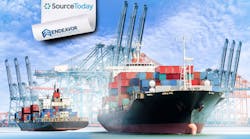Port Congestion Continues to Throttle the World’s Supply Chains
This article appeared in Source Today and has been published here with permission.
Members can download this article in PDF format.
When things run smoothly at the world’s ocean ports, companies get their goods out the door on time, carriers adhere to their delivery commitments and buyers get their items in a predictable, reliable manner.
In most cases, a single supply chain disruption, weather event or geopolitical problem has minimal impact on these smooth-running transportation networks. However, when you add a global pandemic, mandatory business shutdowns and a labor shortage to the mix, a “perfect storm” takes over and throws the entire supply chain for a loop.
That’s exactly what’s happening right now with ocean shipping, where port congestion and a persistent container shortage are just two of the high-level issues that suppliers, carriers, logistics providers and customers are all dealing with right now. “The congestion results from the world’s supply chain continuing to play catch up after initial pandemic-driven lockdowns,” SGB Media reports.
“Demand for imports remains elevated as money diverted from vacations, movies and dining out is heading toward furniture, appliances, exercise equipment, bicycles and other home goods,” SGB continues. “A shortage of dock workers amid coronavirus outbreak threats further complicate port operations.”
What’s Causing the Port Congestion?
According to Hellenic Shipping News, port congestion occurs when ships arrive at port but cannot load or unload because of the already full port capacity. Ships can either queue up and wait for their turn to get a spot at the port or call-in at the nearby port. And while the process generally runs smoothly, the pandemic and other circumstances have disrupted otherwise well-laid plans over the last few months.
When pandemic-led lockdowns disrupted global trade, for example, container shipping alliances responded by curtailing services on certain routes or cancelling (“blanking”) port calls. “This has disturbed the containers demand and availability equilibrium at ports,” the publication reports.
Then, a sudden spike in container volumes emerged as companies rushed to meet the higher demand following the reopening of economies post-lockdowns. Meeting that demand wasn’t easy for ports that are “generally characterized by fixed capacity which cannot be changed/modified to meet the short-term requirements,” Hellenic Shipping News points out.
“Shippers are bearing most of the cost burden as the maritime industry plays a central role in global trade, container shipping alliances dominate in terms of market share, and ports play a vital role in the marine supply chain,” the publication continues. “Container shipping lines pass on the cost of delay to shippers by adding a congestion surcharge to freight rates, while ports and haulers pass on the cost in the form of higher demurrage charges and storage cost.
Taking Steps to Solve the Problem
With the port congestion expected to last well into the summer peak shipping season, at least for some areas of the U.S., the rush is on the solve the problem both for the short- and long-term. American Shipper, for example, details how Port Houston is positioning itself as a “viable option for handling more containerized imports from Asia, thanks to congestion woes for importers on the West and East coasts.”
American Shipper says Yeti, an Austin-based cooler and drinkware manufacturer, is currently testing Port Houston as an alternative to the Port of Los Angeles and Long Beach or Port of New York/New Jersey for importing its shipments from Asia. “We’re seeing some elongated wait times coming through the ports in the process of shipments,” the company’s CEO said. To mitigate wait times and supply chain risks, Yeti is cross-docking its shipments, using different shipping lanes, and leveraging faster shipping lanes out of Southeast Asia to cut down on the transport time, American Shipper reports.
In Georgia, the Port of Savannah is adding new capacity in hopes of reducing congestion.
According to JOC, the Georgia Ports Authority (GPA) will increase capacity in Savannah by 650,000 TEU, a 20% increase, before the end of 2021 to handle volume surges with fewer slowdowns.
Batten Down the Hatches
Looking ahead, Transport Topics says port leaders, industry experts and government officials are becoming increasingly concerned that the world’s largest ports will remain “extremely congested” for the next six months. They blame the flood of products from Southeast Asian factories, a percentage of longshoremen being off the job due to COVID-19 and a shortage of warehouse space nationwide (especially near ports) for exacerbating the problem.
“The workforce itself has been stressed, whether it’s the dray truck drivers or the longshore workers or all the others in the supply chain. They’ve all been whipsawed,” Transportation Economist Paul Bingham told TT. “How long do the restrictions on operations and the social distancing last? That could be quite a while.”
